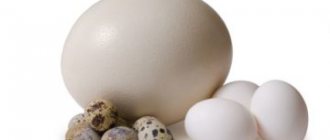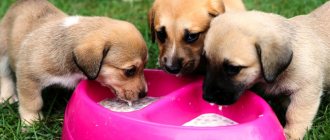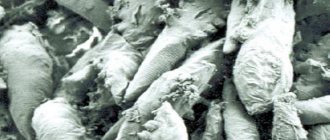Causes of mastitis in dogs
There can be many causes of mastitis in dogs. Depending on the variety, the disease can arise from a variety of factors.
Lactostasis
Mastitis can occur not only due to damage or infections in the mammary gland. It often occurs as a result of lactostasis - excess milk in bitches during the feeding period. Fluid stagnation occurs in the mammary gland due to early weaning of puppies or the birth of still babies.
Injuries, scratches, abrasions
Another serious cause of mastitis is damage to the epidermis in the mammary gland area, that is, scratches, injuries and even small abrasions. In the case of a nursing bitch, this situation occurs due to puppies biting while suckling the mother's breast.
Other reasons
In addition to the above reasons for the occurrence of the disease, there are others:
- disturbance of the animal's hormonal levels;
- diseases of the mammary glands;
- genetic predisposition;
- hypothermia or overheating of the chest area;
- infection;
- illness and decreased immunity of the animal;
- unfavorable and unsanitary conditions for keeping the pet.
Important! Due to destabilization of the functioning of hormones, false pregnancy often occurs, which leads to the appearance of milk.
Redness, swelling, tenderness of the mammary glands in a dog
Paka Natalya Viktorovna, surgeon
Normally, a dog has five pairs of mammary glands. The upper two pairs are called pectoral, the next two are abdominal, and the lower pair of glands are called inguinal. Cats have a similar set, but they often have only four pairs.
Pathologies of the mammary glands can be divided into inflammatory and non-inflammatory.
Pathologies accompanied by inflammation include:
Mastitis is inflammation of the mammary gland. The disease occurs during lactation (feeding babies) or is a complication of false pregnancy and false lactation. The inflamed glands are enlarged, hot and painful, their skin is hyperemic (reddened). When expressing, a secretion containing white flakes is released. The animal is depressed, body temperature is increased by 1-1.5°C. The disease requires urgent contact with a veterinarian.
An abscess is a focal purulent inflammation of the mammary gland, characterized by the formation of a cavity filled with pus. It can manifest as signs of mastitis or extensive ulcers. The significant difference is that the disease occurs regardless of lactation. Requires urgent contact with a veterinary surgeon.
Non-inflammatory pathologies include:
Galactostasis is a disease of unknown origin observed immediately before or shortly after childbirth. It is characterized by blockage of the milk ducts, which is accompanied by pain and difficulty in milk secretion. More often observed with overfeeding. The animal experiences discomfort and pain, sometimes accompanied by a refusal to eat. Treatment consists of fasting for 24 hours, reducing the diet for several days and prescribing diuretics. To reduce swelling of the mammary glands, cold compresses and expressing milk are used.
Agalactia - lack of milk. It can be observed against the background of underdevelopment of the mammary glands or with difficulty in milk separation. The cause of the pathology may be the complex influence of external and hormonal factors. Difficult milk secretion is more treatable. The presence of the disease is indicated by hardening and swelling of the mammary glands in the absence of milk in the nipple canal. The pathology is quite often observed in nervous females who show anxiety and do not allow their cubs to approach their nipples.
Tumors of the mammary glands. More than 50% of all oncological processes in bitches are caused by mammary gland tumors. Approximately half of breast tumors are malignant, and half of these have metastasized by the time they are discovered.
In cats, the disease is observed half as often as in bitches, and in most cases the tumor is a malignant adenocarcinoma (80-90%). As in dogs, the etiology of the disease is unclear. It is assumed that the use of synthetic progestogens increases the risk of developing neoplasms.
According to available data, the risk of developing neoplasia is directly related to the age at which the animal was subjected to ovariohysterectomy. Spaying performed before the first heat reduces the risk of developing breast cancer by up to 0.05%. However, the positive preventive effect of sterilization partially decreases as the bitch gets older, so ovariohysterectomy (removal of the uterus and ovaries) performed at the age of 2.5 years or later no longer has an effect on the development of mammary tumors. These data indicate the benefits of early ovariohysterectomy in the prevention of this disease.
Benign mammary hyperplasia (fibroepithelial hyperplasia). A fairly common disease that occurs in young animals with a normal estrous cycle, in pregnant, castrated and long-term cats receiving progestogen (megestrol acetate). The similarity in the manifestations of the disease in young females and in females receiving progestogen for a long time suggests that the growths are the result of excessive hormonal stimulation. The disease often affects several mammary glands, which enlarge so much that they prevent the animal from moving. The affected glands are swollen and painful, however, the appearance of ulcers is uncharacteristic. Ovariohysterectomy is recommended for young females, but it should be taken into account that regression of the formation may continue for 5-6 months after surgery.
Classification of mastitis
With the catarrhal subtype of the disease, the nipples do not enlarge very much.
Depending on the severity of the disease and symptoms, mastitis is divided into several types.
Catarrhal
When catarrhal mastitis occurs, the animal's nipples do not increase very much, but their temperature increases greatly. In addition, a clear liquid begins to emerge from them. In general, the dog's condition is not very serious.
Serous
Serous mastitis in a nursing dog is characterized by inflammation and increased temperature of the nipples. At the same time, the outflow of milk worsens and a colorless liquid comes out with it.
Note! The serous subtype of the disease in a nulliparous dog is distinguished by the fact that some nipples are much larger in size than the rest.
Fibrous
This subtype of mastitis got its name due to the fact that, together with a clear liquid, light, thin threads are released from the dog’s nipples. The scientific term for this phenomenon is “fibrin threads.” If the nipples are slightly mashed, a soft crunching sound appears.
Purulent
One of the most painful and dangerous subtypes of canine mastitis. When it appears, the animal's milk changes color from white to greenish due to the accumulation of purulent fluid. Inflammation of the nipples is visually very noticeable, and if you press lightly on them, pus will be released.
Phlegmonous
With this type of mastitis, purulent fluid accumulates inside the mammary glands and is not released. The nipples and the area around them feel very hot to the touch.
Abscessing
This disease goes away with severe pain that bothers the dog. Veins become noticeable near the nipples, as they begin to expand as the disease progresses.
Gangrenous
The entire area around the nipples swells, and the upper layer of the epidermis becomes very red. Soon, bubbly and darkened bumps form on it. Of course, in such a severe case, the dog’s milk disappears completely.
When the disease appears, the dog becomes inactive
Types of mastitis
There are several types of breast inflammation.
Catarrhal
We can say that this is the initial stage. And only a specialist can detect it; an ordinary owner is unlikely to notice that mucus has appeared in the dog’s milk. After all, the remaining symptoms have not yet developed. At this stage it is best to begin treatment, otherwise catarrhal mastitis will turn into serous or even purulent.
Serous
This type of mastitis is also not easy to detect without special skill. With this type of inflammation, exudate is released with milk.
Fibrous
If you express a little milk from the diseased dense hot lobe, you will see white fibrin threads.
Purulent
Already from the name of the type of mastitis, it becomes clear that the milk contains impurities of pus (yellowish, greenish), and the smell is unpleasant. The animal's body temperature rises. With this type of inflammation, you cannot do without antibiotics. Warming the diseased lobes with this type of mastitis is strictly prohibited!
Phlegmonous
Phlegmon is the outpouring of pus into the subcutaneous tissue. Surprisingly, there will be no pus in the milk right away; it will appear later, when microorganisms penetrate the mammary glands.
Abscessing
It is rarely diagnosed, but it still happens. With this type of mastitis, the pustules are encapsulated (unlike phlegmon, which is diffuse). Only surgery and antibiotic therapy can help.
Gangrenous
The most severe type of inflammation, in which breast tissue necrotizes (dies). It is extremely difficult to treat, but it also develops extremely rarely.
Symptoms of mastitis in dogs
In the early stages, treating mastitis in dogs at home is almost impossible, since symptoms appear after a certain amount of time. However, in such a situation, the disease has already progressed and the animal must be treated by a veterinarian.
Common clinical signs of mastitis in dogs
The main symptoms of all subtypes of mastitis in dogs are redness of the nipples with swelling, fever, painful spasms and decreased activity.
Symptoms inherent in all types of mastitis:
- decreased activity;
- deterioration of health;
- constant drowsiness;
- redness and inflammation of the nipples;
- heat.
In this state, the female often does not allow the puppies to approach her and refuses to feed them milk.
Local clinical signs of mastitis in a dog
Local clinical symptoms may appear depending on the type of disease, including:
- discharge of whitish or greenish fluid from the nipples;
- blue discoloration of the chest area of the animal;
- swelling or local lumps on the chest;
- enlarged lymph nodes;
Sometimes, in addition to pus, even blood may ooze from the nipples; in this case, it is too late to try to cure the disease on your own; you should immediately consult a doctor.
Treatment
If you suspect your dog has mastitis, you should take your dog to the vet for an examination.
Important! You should not try to treat yourself at home using traditional methods or drugs that people recommend on the Internet.
In this case, the consequences can be much more severe and dangerous for the pet; only a qualified specialist can help.
First aid at home
In the early stages of the disease, treatment can be carried out at home. If the dog does not have purulent discharge, lumps or severe discoloration in the nipple area, you can help it yourself.
It is imperative to express milk twice a day to prevent stagnation. After this, be sure to make a tight bandage. It is also worth treating nipples with camphor oil.
Medicines
Medicines for mastitis in dogs come in different forms and have different effects. They are prescribed directly by the veterinarian.
As a rule, he prescribes certain ointments for external treatment of the mammary glands and antibiotics for oral administration. After this, the doctor must prescribe a course of immunomodulators to strengthen the animal’s immunity.
Milk and dairy products in the diet of dogs
Author Marina Rastorgueva
28.08.2019 13:52
Zoosphere » Dogs
Everyone knows that milk is a very useful product for the human body. It contains many natural ingredients and protein. But should you use dairy products in your pet's diet?
It is worth saying that milk is a controversial product in a dog’s diet. Dairy products will not have a negative impact on the health and functioning of your dog. But you shouldn’t pamper your pet with milk every day, as it contains lactose. The best option would be to buy lactose-free milk for dogs in a specialty store. If you decide to pamper your pet with regular milk, then choose the minimum percentage of fat content.
Cow's milk contains almost 3 times more protein and fat than dog milk. It also contains a lot of phosphorus, iron and lime. If you decide to use this milk to feed puppies, then dilute it with raw chicken eggs. The nutritional value will become balanced.
Features of the disease
Most often, the disease occurs in lactating bitches.
Depending on the breed and age, there are small features of the disease mastitis.
Feeding dog
In lactating bitches, excess milk provokes disturbances in its outflow, causing the mammary glands to harden. However, even with normal feeding, mastitis can occur - when pathogenic microorganisms penetrate the mammary gland through scratches and bites of puppies.
Mastitis in a nulliparous dog
In a nulliparous bitch, the disease occurs most often due to injuries to the mammary gland, false pregnancy and hypothermia. In this case, the animal stops lying on its stomach and begins to behave restlessly. Her nipples do not become inflamed immediately, but after a short amount of time.
old dog
Due to the reduced immunity of adult dogs, there is a high probability of a rapid progression of the disease. Often, in addition to colorless discharge, purulent fluid also flows from the nipples.
Often these animals can only be helped through surgery. What to do if you have mastitis in an old dog? The most important and main advice is to take her urgently to the veterinarian, and not to look for a cure for the disease on your own.
York
Mastitis in Yorkies is a genetic predisposition disease. Unfortunately, this breed is susceptible to this disease, but it can occur in either a normal or mild form.
Pathological causes
Discharge not related to pregnancy and breastfeeding appears for the following reasons:
- False pregnancy . This condition develops 5-8 weeks after estrus and is caused by increased progesterone levels in the absence of pregnancy.
- Mastitis . Inflammation of the mammary glands is caused by bacteria, clostridia, and E. coli. The disease provokes purulent discharge from the dog's nipples. Risk factors include stagnation of milk, damaged nipple skin, and hypothermia.
- Breast duct ectasia . With this disease, the duct expands and becomes clogged with thick contents. The reason lies in hormonal imbalance, injury, inflammation.
- Mastopathy . This condition is caused by an abnormal ratio of cystic and fibrous tissue in the organ and often occurs due to a hormone imbalance.
- Reaction to medications . Taking certain medications, such as chlorpromazine, causes white discharge from the nipples.
- Neoplasm . Among malignant tumors, dogs are most often affected by carcinomas, and among benign tumors, intraductal papillomas are most often affected.
- Injury.
Prevention of mastitis in dogs
To avoid the occurrence of the disease, it is necessary to regularly take your pet to the veterinarian
. To prevent the occurrence of mastitis in dogs, it is best to take preventive measures in advance:
- sterilize females;
- regularly take the animal for examination to the veterinarian;
- keep the room where the dog and puppies are kept sterile;
- protect the animal from drafts and low temperatures;
- regularly examine the bitch’s mammary glands for mechanical damage;
Important! To prevent puppies from scratching their mother, it is necessary to trim their claws.
If your dog has an inflamed nipple, you should definitely take it to the doctor to check for mastitis. This painful disease can cause considerable suffering to the animal, so immediate treatment is required.











